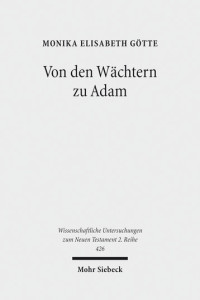In this blog post I would like to provide a short summary of my PhD dissertation ‘Von den Wächtern zu Adam. Frühjüdische Mythen über die Ursprünge des Bösen und ihre frühchristliche Rezeption’, (From the Watchers to Adam. Early Jewish Myths on the Origins of Evil and their Early Christian Reception) which was published in Mohr Siebeck’s Wissenschaftliche Untersuchungen zum Neuen Testament (WUNT) II in October 2016.
In the early Jewish-Christian tradition, the question of the origin of evil is explained through the use of various mythological concepts, such as the idea of a cosmological dualism as found in the treatise on the two spirits (1QS III,13-IV,26) or the later rabbinic concept of the ‘evil inclination’ (jerobablzer ha’ra). Most prominent among these types of explanations of evil are the Enochic myth of the Watchers and the narrative of Adam’s fall. In my dissertation I analysed the development and the reception of these two motifs, revealing a gradual shift of the explanation of evil’s origins from the Watchers to Adam and, later, to the primordial fall of Satan.
Since the discovery of various fragments of 1 Enoch among the Dead Sea Scrolls, it has become possible to date the Enochic corpus (that was formerly almost only known in ge’ez) much earlier than previously suggested. Therefore, the composition of the Book of the Watchers (1 Enoch 6-36) can be moved back to the 3rd century BC. In the time from the 2nd century BC until the beginning of the 1st century AD, the tale of the ‘fallen angels’ (see also Genesis 6,1-4), their giant offspring and the evil spirits emerging from the dead giants was a widespread explanation for the evils on earth, such as violence, idolatry, and fornication. However, the narrative of the first humans in the Garden of Eden and their transgression initiated by the snake, as we find it in Genesis 3, is neither referred to as a potential explanation for evil or sin in the writings that we now find in the Hebrew Bible, nor in the writings of Early Judaism. On the contrary, the tale that has become the explanation for evil and sin on earth in Christian theology is first referred to in the context of sin and evil in Paul’s epistle to the Romans (“Therefore, just as sin came into the world through one man, and death came through sin, and so death spread to all because all have sinned…”, Romans 5,12 NRSV). Later on, for example in the Apocalypsis Mosis and the Vita Adae et Evae, the Eden narrative is connected to the idea of Satan as a fallen archangel who takes his revenge on humans by leading them to transgression.
Through the analyses of the Watcher and the Eden narrative and their respective history of reception, the following implications become apparent and are here roughly summarized: From the 1st century AD, the Genesis 3 narrative became more important, whereas the Watcher-myth lost influence. The gradual shift from the Watchers to Adam also implies a shift from human fate to human responsibility: The myth of the watchers implies (at first) no human guilt but locates the origin of evil in the ‘divine sphere’. The transgression of Adam however implies human guilt and sin as the origin of evil.
There was, despite an obvious preference for one or another conception of evil at different times and in relation to different concerns of communication, at no time a ‘master explanation’ or a ‘master narrative’ of the origin of evil. Rather, there is a plurality of explanations of evil within the biblical and the early Christian tradition that leads to hermeneutical issues: If evil is not explained in a uniform and definitive manner but is left open in a multifaceted interplay of motifs, what does this mean? First, the plurality of explanations reflects the variety and vivacity of Jewish theology and its adaptability in view of different historical and/or theological challenges. The classification of evil is therefore variable depending on situation and intention: What is interpreted as ‘evil’, be it as sin or fatal destiny, is at first due to experience and not to dogma. The rating of something as ‘evil’ is thus in a certain way arbitrary. At the same time is it exactly this plurality of interpretation that preserves the connectivity to experience.
Finally, the contextual interpretation of evil and its origins (‘what’, ‘for whom’ and ‘why’) leads to the assumption that the question of evil didn’t have to be answered unambiguously (‘dogmatic’). The answer to the question of the origin of evil is subordinated to the theological idea of the one and almighty God of Israel. Under that assumption it is clear that there can be no independent force of evil in a strongly dualistic sense (as perhaps an ‘anti-God’ or a demiurge); at the same time, still under the ‘monotheistic assumption’, there are a lot of possible varieties of divine, angelic, human, satanic, or demonic involvement in the origin of evil.
Dr. Monika Götte (*1985) wrote her PhD dissertation at UZH (University of Zurich) and is currently working as a Pastor in Stäfa (ZH).


Keine Kommentare vorhanden
Es gibt noch keine Kommentare.
Kommentar schreiben